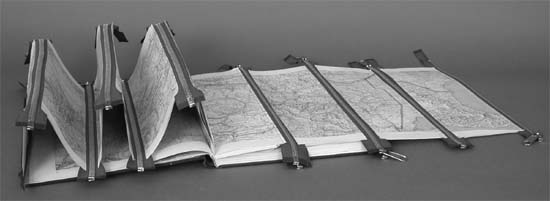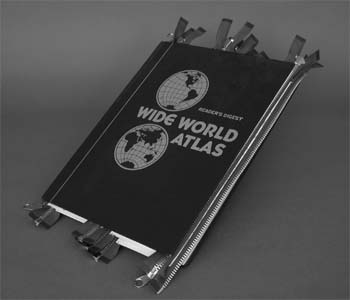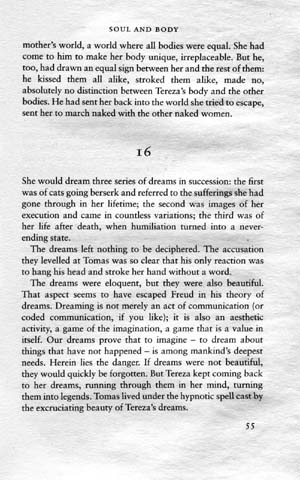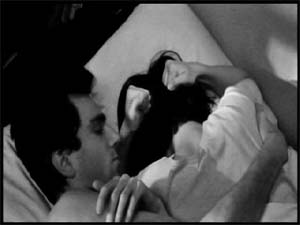Smart Book Art
Doug Beube is from Canada and now lives in America. Mari Jorstad is from Norway and now lives in Canada. Both are practicing artists -one established and one on the rise -who look past the literary and literal meaning of books. Here’s what they had to say about being ex-pat, indie artists who work with the book form.
By Erin Kobayashi
Doug Beube is a mixed media artist who works almost exclusively with books. He is originally from Hamilton, Canada and studied photography at York University. He now resides in Brooklyn and continues to make book art. He also curates the Chasanoff collection, which has over 280 bookworks from various artists including Yoko Ono, Sjoerd Hofstra and Buzz Spector.
What is a book artist?
A book artist is a term that is derived from alternative means of all art. It is not really pejorative term but I think it is. The reason is that those working with the idea of artist’s books, bookworks and livres d’artistes, within the field, you have these different genres beacsue each one addresses different issues and topics. Book artists generally refers to someone who almost working exclusively in that field and it generally referes to someone who uses paginated works. I call myself a mixed media artist because I come from photography and from photography I relate one photograph to another picture. And I began to work with artists’ books which are paginated works with ideas of image and text. And then I began to take traditional books binding and took books apart, that’s when I moved from working with artists’ books to fine binding to deconstructing books or bookworks. That person tends to be someone who works almost exclusively with the ideas, images or text in the book format. That is what a book artist is. People might consider my work as sculpture rather than book art. When people introduce me as a book artist, I almost cringe a little bit because I work with neon, photography, installation.
How many book artists are around today?
There are thousands literally in every country. It’s a worldwide movement. Every year, at Printed Matter in New York there are offsite exhibitions or conferences that detail these various artists that work in the field.
How did you start working with books?
I kept a journal when I was twenty and loved the secrecy of this would be my personal journal that I kept in these black books. And then I had photography that was more public. So I had private and public and in graduate school that is when I combined photography and books. I learned how to bind books, of binding and combining and sequence. So I physically put the pictures together. Then I studied books and binding and I began to move from traditional photography to artist’s books and then from there I deconstructed books. And became interested in the relationship with technology of the book and this is where I am today. We are still using the technology of a book that is from the 15th century because of its convenience today. I am interested in the computer and how the computer facilitates information both image and text very quickly.
You have a metaphor that compares the book to the human body, can you explain that further?
For me the metaphor of the human body to the book was more akin to my thinking. You have a spine, the cover and the appendages metaphorically with the human body to the book.
You have the content within and with the book you have to actually open up the book to read it. When you read the entire book, the abstraction becomes a concrete idea so if we were reading a novel, we get glimpses of that novel but we have to read the entire novel to capture the essence of what that book is. There’s a transparency that I try to do in my work with the way there is a transparency when you look at someone, where I can tell as a photographer, with how open a person can be.
You talk a lot about the environment and organic materials which is a really relevant topic today. What is your organic book art?
That started in 1980. I always loved trees and walking and watching nature transform. Even as I kid I used to dissect frogs and worms for school and that sensibility of being a scientist, which didn’t express the feeling side for me. So when I moved into books, very early on, just intuitively I made paper and I wanted to build the paper on top of one another and I wanted to watch the paper germinate and generate. That sensibility of watching something grow and transpire and mutate and morph is very much part of watching the character shift in a novel. It’s the same kind of shifting in the organic works that I do. Very quickly a viewer can see this transference of energy from seed to sprout to fully grown to collapse to degeneration which became a metaphor again for the human cycle of life. These organic books are a microcosmic view of how the world is treated. Once these books grow and die very quickly, it looks a caveperson could have made them.
You also view books as objects that are not sacred, that are constantly tossed away and become garbage.
That is both a positive and negative of our culture. Sometime it requires time to elapse to see how significant a book was.
There are authors who write a piece where it takes five to one hundred years to see how significant they are, like Galileo. It happens in painting as well. Although librarians are saving books that are being thrown away, it doesn’t make it insignificant, it just means our attention is not on that particular subject. Where I get most of my books, people throw them out because they have multiple copies. Sometimes I get criticized for mutilating a book, whether they are Bibles or edition books, I still use them because it is not the last one. I feel that when a book is thrown out, it is a life that is saved because there is a life experience within that book and I will retell that story. Recycling is essential today so that is another part of why book arts and bookworks are significant. The Portland Public Library had 10,000 copies of books they were going to throw out and Adriane Herman and Michael Whittaker got the idea for a book grab, which gives the books out to artists and then the artists donate the books back to the library in a year. These books as bookworks will become part of the interlibrary loan. I showed my own work and the work from the Allan Chasanoff bookworks collection. This idea of recycling is prevalent, rather than just putting it into a landfill, the book becomes significant for others who may have not experienced it before.
You are an ex-pat living in Brooklyn, why did you decide to move to America?
I moved here because of my artwork. I traveled with a circus and photographed circuses. I got Ontario Arts Council grants. I got the bite of America. My mentor, Minor White, was here and I moved here in the early 70s. I just stayed on. My sensibility was American but I still have family in Canada. I think there are opportunities in the US that I couldn’t have in Canada. There are more collectors of my work here and more support of the Allan Chasanoff collection that I curate. I could not have done what I do here in Canada, in Toronto, Montreal, Winnipeg, Vancouver.
What is your favourite book collection in the world?
There are artist book collection that almost every major university and museum collects. The MOMA has almost every artist book that Art Metropole, Printed Matter and Franklin Furnace has either exhibited or printed. I don’t think Canada has that. There are very few universities and institutions are committed the way Yale, UCLA, University of Iowa who collects artist books. Canada, again, is not as supportive which is why you have a lot of artists in the states. In terms of bookwork collections that are not specifically artist’s books, of course, the Chasanoff collection, the Arthur Jaffe collection in Florida, he’s now given his collection away. The Ruth and Marvin Sackner is a brilliant collection. There are very few collections that exist like this in the world.
Mari Jorstad is a young artist who makes her work using books. She is originally from Hovag in Norway. She now resides in Toronto and currently attends the University of Toronto.
Can you give a little background about growing up in Norway?
I grew up in a tiny place in Southern Norway called Hovag. It is by the ocean, and during the summers I’d spend the majority of my time in the water. I went to a small school where my classmates were the same from grade one through grade eight. My favourite things to do were to make and act out stories, dress up and read.
How did Norway affect you as an artist?
Some of my art pieces directly reflect my Norwegian background, as I try to integrate the Norwegian and Canadian parts of my identity. For example, I have one piece called “forty”, which consists of two books of photographs. The first book is called “Blikksund” and contains forty pictures taken of the ocean close to my house in Norway. The pictures are of the same scene, but taken at forty different times. The second book is called “Maureen/Mark” and contains pictures of my Canadian friend Maureen reading the gospel of Mark. The piece engages my experience of God through my time in Norway and Canada.
Being Norwegian influences my art alongside many other things. Being an immigrant is certainly part of my identity and affects everything I do. However, it is not the only thing that influences my art, nor my primary influence. I think that often it influences me in ways I am not entirely aware of, as the effects of moving and of living in different places is not crystal clear to me.
When you first came to Canada, how old were you and what were your impressions of the country?
I first came to Canada when I was fourteen, as my dad got a two-year long job in Toronto. My first experience of Canada was spending hours and hours in immigration with my mom, as my sisters and I were nowhere to be found in the immigration computer system. We finally made it through immigration and met up with my dad. We arrived in August, and it was hot and humid. On the way to our house, we stopped at a grocery store, and I remember being very impressed with its size. It was much bigger than grocery stores in Norway. For the first few months, my family and I lived in North York, and I found it ugly. Later we moved to the Danforth area, which I found much more aesthetically pleasing, especially in the spring and summer when the trees form a roof over the side streets. The multiculturalism of Toronto also made a strong impression upon arrival, as I was not used to being around people from all over the world. It was a bit disorienting at first, but exciting.
How had you changed, when you returned to Norway to complete two years of high school?
Coming back to Norway I did not expect to experience reverse culture shock. Coming to Toronto I knew that things would be different, and that it would take time to get used to, but I did not expect that it would the same moving back to Norway. Trying to reconnect with friends was hard, because I was not used to Norwegian social patterns anymore. I can’t specify exactly what the change consisted of, except that it was very disorienting. Like most culture shocks it got better with time, but the first few months were hard.
Why did you move back to Canada?
I had two main reasons for moving back to Canada. The first was that I really missed Toronto and wanted to come back. Secondly, the chances of getting into a fine art program in Norway were not great, and coming here solved that problem.
When did you first get the idea to use books?
The first piece I did that directly involved books was for a design class assignment named “How did I get here?” I chose to make a timeline of books, where I scanned one page from approximately hundred books that have been important to me throughout my life, and arranged them in chronological order based on when I had read each book. The piece made me think about the influence reading has had and continues to have on me. It also helped me realize that I could use the aesthetics of books in my pieces, and that text can be used as image.
Can you explain your Unbearable Lightness of Being piece and how it works?
The Unbearable Lightness of Being piece compares the telling of stories in two mediums. It consists of two projections, one is a page from the book and the other is a four second segment from the movie version of the story, placed on a loop. The segment from the movie corresponds to the page from the book but communicate similar ideas very differently. The main idea is to compare how different mediums communicate and how they affect that which they communicate. Making books into movies is a popular thing to do lately and I find it interesting how the story transforms as it is put to film.
Why are you drawn to using certain books in your art work?
I use books that I like, and that I think about over time. I don’t usually use a book that I have read recently, but rather books that I have read and reread. I usually use books in pieces by manipulating the text itself, so the type and paper of books also influence my decisions. Some books lead to visual ideas and some don’t. Sometimes I really want to use a book but I can’t think of a good way of engaging with it in an art piece.
What other books have you based your art on?
Till We Have Faces by C. S. Lewis, The God of Small Things by Arundhati Roy, The Bible, The Elimination Dance by Michael Ondaatje. Some of my pieces do not use one book in particular, but a range of books. For example, I made a chair that reads Norwegian children stories to whoever sits in it.
What is your all-time favourite book?
Choosing one particular book is just about impossible. As soon as I learned to read, I read everything I could get my hands on. At best, I can list a handful of books that I currently like the most. I love The God of Small Things by Arundhati Roy. Her use of language is extraordinary, very playful and beautiful. As a youth I was obsessed with Lord of the Rings. Life of Pi and Fugitive Pieces are Can Lit favorites. The Robber’s Daughter and Mio are childhood favorites.




